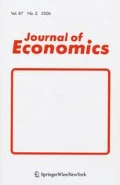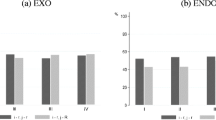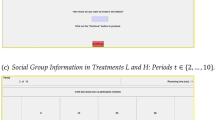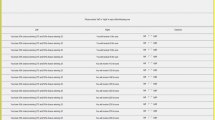Abstract
A standard risk-sharing matching game predicts negative assortative matching over agents’ risk attitudes. In regards to risk sharing, less risk-averse agents prefer highly risk-averse partners, who pay a high risk premium. Negative sorting is, however, inconsistent with empirical and experimental literature. To resolve this conflict, we propose a model where agents can control the risks to their incomes. In regards to risk management, agents prefer similar partners because of their aligned objectives in risk management. When it is easy to control risks or all agents are sufficiently risk-averse, the risk-management effect dominates, leading to positive sorting.
Similar content being viewed by others
Notes
Concerning the exact meaning of an elasticity of 2, we provide an economic explanation in the Appendix B. If the only way of controlling risk is to allocate agents’ wealth between a risk free asset and a risky asset, then the elasticity of the optimal variance w.r.t. the representative risk aversion R is exactly equal to 2, leading to arbitrary matching pattern. Positive assortative matching is possible if the agent has other means of controlling risks.
In Appendix B, we model endogenous risk as a portfolio choice problem following Di Cagno et al. (2011). The resultant matching pattern in the game contrasts with that in the standard literature, on matching to share risk.
References
Altug S, Miller R (1990) Household choices in equilibrium. Econometrica: J Econom Soc 58(3):543–570
Becker G (1973) A theory of marriage: part I. J Politic Econ 81:813–846
Becker G (1974) A theory of marriage: part II. J Politic Econ 82(2):S11–S26
Charles KK, Hurst E (2003) The correlation of wealth across generations. J Politic Econ 111(6):1155–1182
Chiappori P, Reny P (2006) Matching to share risk. Mimeo, University of Chicago
Conning J (1999) Outreach, sustainability and leverage in monitored and peer-monitored lending. J Dev Econ 60(1):51–77
Di Cagno D, Sciubba E, Spallone M (2011) Choosing a gambling partner: testing a model of mutual insurance in the lab. Theory Decis (in press)
Fafchamps M, Lund S (2003) Risk-sharing networks in rural Philippines. J Dev Econ 71(2):261–287
Ghatak M (1999) Group lending, local information and peer selection. J. Dev Econ 60(1):27–50
Hayashi F, Altonji J, Kotlikoff L (1996) Risk-sharing between and within families. Econometrica: J Econometric Soc 64:261–294
Hess G (2004) Marriage and consumption insurance: what’s love got to do with it? J Polit Econ 112:290–318
Kotlikoff LJ, Spivak A (1981) The family as an incomplete annuities market. J Polit Econ 89(2):372–391
Laczó S, Gierlinger J (2012) Matching and self-enforcing insurance
Lam D (1988) Marriage markets and assortative mating with household public goods: theoretical results and empirical implications. J Hum Resour 23(4):462–487
Legros P, Newman A (2007) Beauty is a beast, frog is a prince: assortative matching with nontransferabilities. Econometrica 75:1073–1102
Ligon E, Thomas J, Worrall T (2002) Informal insurance arrangements with limited commitment: theory and evidence from village economies. Rev Econ Stud 69(1):209
Rosenzweig M (1988) Risk, implicit contracts and the family in rural areas of low-income countries. Econ J 98(393):1148–1170
Rosenzweig M, Stark O (1989) Consumption smoothing, migration, and marriage: evidence from rural India. J Polit Econ 97:905–926
Schulhofer-Wohl S (2006) Negative assortative matching of risk-averse agents with transferable expected utility. Econ Lett 92(3):383–388
Stiglitz JE (1990) Peer monitoring and credit markets. World Bank Econ Rev 4(3):351–366
Townsend R (1994) Risk and insurance in village india. Econometrica: J Econometric Soc 62:539–591
Wilson R (1968) The theory of syndicates. Econometrica 36(1):119–132
Acknowledgments
This research is supported by the Fundamental Research Funds for the Central Universities, and the Research Funds of Renmin University of China (12XNK019). We thank Francis Bloch, Louis Eeckhoudt, Christian Gollier, Patrick Legros and Francois Sanalie for helpful comments. We also thank Peter Kelly for revising the language of this paper.
Author information
Authors and Affiliations
Corresponding authors
Appendices
Appendix A: Proof of Lemma 1
Proof
F.O.C of (1) is
Taking a log on both sides and use the specific form of CARA, we have
which gives
and
Individual \(i\)’s certainty equivalent of consuming \(\tilde{Y} _{ij}-c_{ij}-\psi ( \mu _{i},\sigma _{i}^{2})\) is (using the assumptions CARA + normal distribution):
and individual \(j\)’s certainty equivalent of consuming \(c_{ij}-\psi ( \mu _{j},\sigma _{j}^{2})\) is
One can also refer to Schulhofer-Wohl (2006), who provides the general results for ISHARA preference, with CARA as a special case.
Appendix B: Modeling endogenous risks as portfolio choice
In this section, we model the endogenous risks as a portfolio choice. The game is similar to that in Di Cagno et al. (2011). In particular, each agent is endowed with 50 cents. At period 0 each agent voluntarily matches with a mate from the opposite side. A couple hence has total wealth of one dollar. Each couple \((i,j)\) will commit to invest \(1-\alpha \in [0,1]\) dollars in a risk free asset with gross return \(\mu _{1}\) and \(\alpha \) in a normally distributed risky asset with mean \(\mu _{2}\) and variance \(\sigma ^{2}\). Assume \(\mu _{2}>\mu _{1}\). The agents will also commit to rules for sharing their income in each state of the world. At period 1, agents invest according to the committed actions. Then, the value of all shocks are realized and agents consume according to the prior sharing rules.
For a matched couple, they will choose \(\alpha \) to maximize the household certainty equivalent:
Taking F.O.C. gives
Notice that \(\alpha \) is increasing in the risk premium \(\mu _{2}-\mu _{1}\), and decreasing in the riskiness of the risky asset and the representative agent’s degree of risk aversion. The household certainty equivalent \(C\) is a function of the representative agent’s coefficient of risk aversion \(R\). By Proposition 3, NAM arises if an only if
By the Envelope Theorem, we have \(C^{\prime }( R) =-\frac{\alpha ^{2}\sigma ^{2}}{2}<0\), and \(C^{\prime \prime }( R) =-\alpha \sigma ^{2}\frac{\partial \alpha }{\partial R}>0\): \(C\) is decreasing and convex in \(R\). Again, here we have two opposite effects. The second term \( C_{ij}^{*\prime }( R) \frac{\partial ^{2}R}{\partial r_{i}\partial r_{j}}\) reflects the standard risk-sharing effect for exogenous \(\alpha \). This term is negative and drives the matching pattern to be negatively assortative. The first term is due to the fact that agents can optimally choose \(\alpha \) and hence it reflects the risk-management effect. \(C\) is convex in \(R\), so this term is positive. The risk-management effect drives the matching pattern to be positively assortative.
Substituting \(C^{\prime }( R) =-\frac{\alpha ^{2}\sigma ^{2}}{2}\), \(C^{\prime \prime }( R) =-\alpha \sigma ^{2}\frac{\partial \alpha }{\partial R}\) and (14) into (15), we get
A less risk-averse agent prefers a highly risk-averse agent who pays a high risk premium. But then the collective investment in the risky asset is much less than his preferred amount. The risk-sharing effect and the risk-management effect offset each other. Hence, the matching pattern is arbitrary. That the two effects offset each other depends crucially on our specific assumption of CARA preference and normal distribution. But again, we see that the equilibrium matching pattern balances the trade-off between risk sharing and risk managing. We leave it to future work to explore the case of general preferences and general distributions.
Rights and permissions
About this article
Cite this article
Li, S., Sun, H. & Chen, P. Assortative matching of risk-averse agents with endogenous risk. J Econ 109, 27–40 (2013). https://doi.org/10.1007/s00712-012-0323-3
Received:
Accepted:
Published:
Issue Date:
DOI: https://doi.org/10.1007/s00712-012-0323-3




